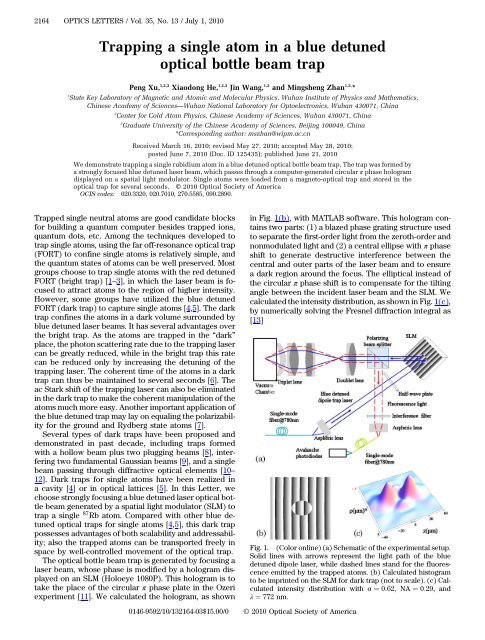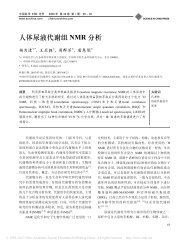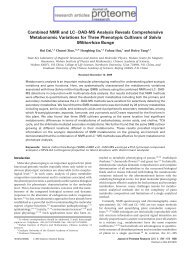Trapping a single atom in a blue detuned optical bottle beam trap
Trapping a single atom in a blue detuned optical bottle beam trap
Trapping a single atom in a blue detuned optical bottle beam trap
Create successful ePaper yourself
Turn your PDF publications into a flip-book with our unique Google optimized e-Paper software.
2164 OPTICS LETTERS / Vol. 35, No. 13 / July 1, 2010<strong>Trapp<strong>in</strong>g</strong> a <strong>s<strong>in</strong>gle</strong> <strong>atom</strong> <strong>in</strong> a <strong>blue</strong> <strong>detuned</strong><strong>optical</strong> <strong>bottle</strong> <strong>beam</strong> <strong>trap</strong>Peng Xu, 1,2,3 Xiaodong He, 1,2,3 J<strong>in</strong> Wang, 1,2 and M<strong>in</strong>gsheng Zhan 1,2, *1State Key Laboratory of Magnetic and Atomic and Molecular Physics, Wuhan Institute of Physics and Mathematics,Ch<strong>in</strong>ese Academy of Sciences—Wuhan National Laboratory for Optoelectronics, Wuhan 430071, Ch<strong>in</strong>a2Center for Cold Atom Physics, Ch<strong>in</strong>ese Academy of Sciences, Wuhan 430071, Ch<strong>in</strong>a3Graduate University of the Ch<strong>in</strong>ese Academy of Sciences, Beij<strong>in</strong>g 100049, Ch<strong>in</strong>a*Correspond<strong>in</strong>g author: mszhan@wipm.ac.cnReceived March 16, 2010; revised May 27, 2010; accepted May 28, 2010;posted June 7, 2010 (Doc. ID 125435); published June 21, 2010We demonstrate <strong>trap</strong>p<strong>in</strong>g a <strong>s<strong>in</strong>gle</strong> rubidium <strong>atom</strong> <strong>in</strong> a <strong>blue</strong> <strong>detuned</strong> <strong>optical</strong> <strong>bottle</strong> <strong>beam</strong> <strong>trap</strong>. The <strong>trap</strong> was formed bya strongly focused <strong>blue</strong> <strong>detuned</strong> laser <strong>beam</strong>, which passes through a computer-generated circular π phase hologramdisplayed on a spatial light modulator. S<strong>in</strong>gle <strong>atom</strong>s were loaded from a magneto-<strong>optical</strong> <strong>trap</strong> and stored <strong>in</strong> the<strong>optical</strong> <strong>trap</strong> for several seconds. © 2010 Optical Society of AmericaOCIS codes: 020.3320, 020.7010, 270.5585, 090.2890.Trapped <strong>s<strong>in</strong>gle</strong> neutral <strong>atom</strong>s are good candidate blocksfor build<strong>in</strong>g a quantum computer besides <strong>trap</strong>ped ions,quantum dots, etc. Among the techniques developed to<strong>trap</strong> <strong>s<strong>in</strong>gle</strong> <strong>atom</strong>s, us<strong>in</strong>g the far off-resonance <strong>optical</strong> <strong>trap</strong>(FORT) to conf<strong>in</strong>e <strong>s<strong>in</strong>gle</strong> <strong>atom</strong>s is relatively simple, andthe quantum states of <strong>atom</strong>s can be well preserved. Mostgroups choose to <strong>trap</strong> <strong>s<strong>in</strong>gle</strong> <strong>atom</strong>s with the red <strong>detuned</strong>FORT (bright <strong>trap</strong>) [1–3], <strong>in</strong> which the laser <strong>beam</strong> is focusedto attract <strong>atom</strong>s to the region of higher <strong>in</strong>tensity.However, some groups have utilized the <strong>blue</strong> <strong>detuned</strong>FORT (dark <strong>trap</strong>) to capture <strong>s<strong>in</strong>gle</strong> <strong>atom</strong>s [4,5]. The dark<strong>trap</strong> conf<strong>in</strong>es the <strong>atom</strong>s <strong>in</strong> a dark volume surrounded by<strong>blue</strong> <strong>detuned</strong> laser <strong>beam</strong>s. It has several advantages overthe bright <strong>trap</strong>. As the <strong>atom</strong>s are <strong>trap</strong>ped <strong>in</strong> the “dark”place, the photon scatter<strong>in</strong>g rate due to the <strong>trap</strong>p<strong>in</strong>g lasercan be greatly reduced, while <strong>in</strong> the bright <strong>trap</strong> this ratecan be reduced only by <strong>in</strong>creas<strong>in</strong>g the detun<strong>in</strong>g of the<strong>trap</strong>p<strong>in</strong>g laser. The coherent time of the <strong>atom</strong>s <strong>in</strong> a dark<strong>trap</strong> can thus be ma<strong>in</strong>ta<strong>in</strong>ed to several seconds [6]. Theac Stark shift of the <strong>trap</strong>p<strong>in</strong>g laser can also be elim<strong>in</strong>ated<strong>in</strong> the dark <strong>trap</strong> to make the coherent manipulation of the<strong>atom</strong>s much more easy. Another important application ofthe <strong>blue</strong> <strong>detuned</strong> <strong>trap</strong> may lay on equal<strong>in</strong>g the polarizabilityfor the ground and Rydberg state <strong>atom</strong>s [7].Several types of dark <strong>trap</strong>s have been proposed anddemonstrated <strong>in</strong> past decade, <strong>in</strong>clud<strong>in</strong>g <strong>trap</strong>s formedwith a hollow <strong>beam</strong> plus two plugg<strong>in</strong>g <strong>beam</strong>s [8], <strong>in</strong>terfer<strong>in</strong>gtwo fundamental Gaussian <strong>beam</strong>s [9], and a <strong>s<strong>in</strong>gle</strong><strong>beam</strong> pass<strong>in</strong>g through diffractive <strong>optical</strong> elements [10–12]. Dark <strong>trap</strong>s for <strong>s<strong>in</strong>gle</strong> <strong>atom</strong>s have been realized <strong>in</strong>a cavity [4] or <strong>in</strong> <strong>optical</strong> lattices [5]. In this Letter, wechoose strongly focus<strong>in</strong>g a <strong>blue</strong> <strong>detuned</strong> laser <strong>optical</strong> <strong>bottle</strong><strong>beam</strong> generated by a spatial light modulator (SLM) to<strong>trap</strong> a <strong>s<strong>in</strong>gle</strong> 87 Rb <strong>atom</strong>. Compared with other <strong>blue</strong> <strong>detuned</strong><strong>optical</strong> <strong>trap</strong>s for <strong>s<strong>in</strong>gle</strong> <strong>atom</strong>s [4,5], this dark <strong>trap</strong>possesses advantages of both scalability and addressability;also the <strong>trap</strong>ped <strong>atom</strong>s can be transported freely <strong>in</strong>space by well-controlled movement of the <strong>optical</strong> <strong>trap</strong>.The <strong>optical</strong> <strong>bottle</strong> <strong>beam</strong> <strong>trap</strong> is generated by focus<strong>in</strong>g alaser <strong>beam</strong>, whose phase is modified by a hologram displayedon an SLM (Holoeye 1080P). This hologram is totake the place of the circular π phase plate <strong>in</strong> the Ozeriexperiment [11]. We calculated the hologram, as shown<strong>in</strong> Fig. 1(b), with MATLAB software. This hologram conta<strong>in</strong>stwo parts: (1) a blazed phase grat<strong>in</strong>g structure usedto separate the first-order light from the zeroth-order andnonmodulated light and (2) a central ellipse with π phaseshift to generate destructive <strong>in</strong>terference between thecentral and outer parts of the laser <strong>beam</strong> and to ensurea dark region around the focus. The elliptical <strong>in</strong>stead ofthe circular π phase shift is to compensate for the tilt<strong>in</strong>gangle between the <strong>in</strong>cident laser <strong>beam</strong> and the SLM. Wecalculated the <strong>in</strong>tensity distribution, as shown <strong>in</strong> Fig. 1(c),by numerically solv<strong>in</strong>g the Fresnel diffraction <strong>in</strong>tegral as[13]Fig. 1. (Color onl<strong>in</strong>e) (a) Schematic of the experimental setup.Solid l<strong>in</strong>es with arrows represent the light path of the <strong>blue</strong><strong>detuned</strong> dipole laser, while dashed l<strong>in</strong>es stand for the fluorescenceemitted by the <strong>trap</strong>ped <strong>atom</strong>s. (b) Calculated histogramto be impr<strong>in</strong>ted on the SLM for dark <strong>trap</strong> (not to scale). (c) Calculated<strong>in</strong>tensity distribution with a ¼ 0:62, NA ¼ 0:29, andλ ¼ 772 nm.0146-9592/10/132164-03$15.00/0 © 2010 Optical Society of America
July 1, 2010 / Vol. 35, No. 13 / OPTICS LETTERS 2165Eðρ; μÞ ¼ 2 Z 11 − e −1 r expð−r 2 ÞJ 0 ðρrÞ0× exp− 1 22 iμr2 dr − 2and× J 0 ðρrÞ exp− 1 2 iμr2 dr;1 − e −1 Z a 0Iðρ; μÞ ¼∣Eðρ; μÞ∣ 2 ;r expð−r 2 Þð1Þð2Þwhere ρ ¼ 2π λ ðNAÞR and μ ¼ 2π λ ðNAÞ2 Z with a be<strong>in</strong>g thenormalized radius of the phase shift, λ the wavelengthof the dipole laser, R the radial coord<strong>in</strong>ate, and Z theaxial coord<strong>in</strong>ate.The dipole laser is from a Ti:sapphire laser (CoherentMBR-110) with a wavelength of 772 nm, which is <strong>blue</strong> <strong>detuned</strong>to the D2 l<strong>in</strong>e of 87 Rb. To form the dark <strong>trap</strong>, thedipole laser <strong>in</strong>cident to the SLM is collimated to a waist of1:36 mm and the elliptical phase shift displayed on theSLM has a 1:90 mm major axis (horizontal) and a1:84 mm m<strong>in</strong>or axis (vertical). We use a commercial microscopeobjective (NA ¼ 0:38, LINOS) to strongly focusthe dipole laser. The focus status is identified and recordedby an aberration-free objective group to a CCDwith 80× magnification. We compare the focus <strong>in</strong> Fig. 2with theoretically calculated ones. Good agreement betweentheory and experiment can be seen from Fig. 2,and the little difference <strong>in</strong> diameter is due to the imperfectexpand<strong>in</strong>g and focus<strong>in</strong>g of the dipole laser. The measureddiameter of the surrounded dark region <strong>in</strong> the focalplane is about 6 μm. The ratio between <strong>in</strong>tensities of the<strong>trap</strong> center and the <strong>trap</strong> wall, also called darkness, ismeasured to be 1:200 by scann<strong>in</strong>g through the focal planewith a p<strong>in</strong>hole.The magneto-<strong>optical</strong> <strong>trap</strong> (MOT) is the same as <strong>in</strong> [3].We used a dipole laser power of 80 mW, correspond<strong>in</strong>gto an <strong>optical</strong> potential of about 1 mK of the dark <strong>trap</strong>,accord<strong>in</strong>g to [14]. To load <strong>atom</strong>s from the MOT to thedark <strong>trap</strong>, we adjusted the focus of the dipole laser tooverlap with the MOT. Meanwhile, to let an <strong>atom</strong> overcomethe potential barrier and to enter the dark region,we shut off the <strong>trap</strong>p<strong>in</strong>g laser for a while and then turnedon the laser aga<strong>in</strong> to hold the <strong>atom</strong>. We took 40 ms as acycle <strong>in</strong> the time sequence with the laser off for the start<strong>in</strong>g1 ms and the laser on for the follow<strong>in</strong>g 39 ms (thecaptur<strong>in</strong>g cycle). The fluorescence of the <strong>trap</strong>ped <strong>atom</strong>s<strong>in</strong>duced by MOT light was collected by the same commercialmicroscope objective, as shown <strong>in</strong> Fig. 1(a). Apolariz<strong>in</strong>g <strong>beam</strong> splitter separated the fluorescence fromthe dipole laser while los<strong>in</strong>g half of the signals. Two <strong>in</strong>terferencefilters (Semrock LL01-780-12.5) were used toblock the stray light of the dipole <strong>trap</strong> laser. The fluorescencewas then coupled to a <strong>s<strong>in</strong>gle</strong>-mode fiber with adiameter of 10 μm for spatial filter<strong>in</strong>g and guided to a<strong>s<strong>in</strong>gle</strong>-photon count<strong>in</strong>g module [(SPCM), EG&G AQRH-14-FC].The time sequence is crucial for this experiment. Wetake the captur<strong>in</strong>g cycle cont<strong>in</strong>uously until the countsof fluorescence with a time b<strong>in</strong> of 40 ms exceed a threshold,then the laser is kept on (the hold<strong>in</strong>g cycle) until thecount falls below the threshold to repeat the captur<strong>in</strong>gcycle. Figure 3(a) shows the counts recorded follow<strong>in</strong>gthis sequence. The sudden rais<strong>in</strong>g and fall<strong>in</strong>g of thecounts <strong>in</strong>dicate an <strong>atom</strong> enter<strong>in</strong>g and leav<strong>in</strong>g the <strong>trap</strong>.The two stages of counts represent no <strong>atom</strong> and one<strong>atom</strong> <strong>in</strong> the <strong>trap</strong>. We believe there is only one <strong>atom</strong> <strong>in</strong>the dark <strong>trap</strong> based on two reasons. First, theoretically,light-assisted collision by the MOT light will eject two ormore <strong>atom</strong>s <strong>in</strong> a very small <strong>trap</strong> volume quickly out of arelatively low <strong>trap</strong>, known as the collisional blockade[15] mechanism. Our dark <strong>trap</strong> radius is 3 μm <strong>in</strong> the focalplane, and the <strong>optical</strong> potential is 1 mK. Under these conditions,when two or more <strong>atom</strong>s enter the <strong>trap</strong>, they willcollide and quickly leave the <strong>trap</strong>, so the <strong>trap</strong> can captureonly one <strong>atom</strong> or no <strong>atom</strong>. Second, experimentally we geta histogram of the counts recorded <strong>in</strong> a total time of2600 s, as shown <strong>in</strong> Fig. 3(b), and we fit it to a compoundPoisson function. From the curve, it is clear that the onlytwo peaks represent events of <strong>atom</strong> number N ¼ 0 andN ¼ 1, with the N ¼ 2 peak miss<strong>in</strong>g. This <strong>in</strong>dicates thatFig. 2. (Color onl<strong>in</strong>e) Intensity cross sections and correspond<strong>in</strong>g<strong>beam</strong> profiles of the dark <strong>trap</strong> near the <strong>beam</strong> focus. Imagesare theoretically calculated (left) and experimentally observed(right) along the <strong>optical</strong> axis, away from the focus with 0, Z R =4,and Z R =2, where Z R is the Rayleigh range.Fig. 3. (Color onl<strong>in</strong>e) (a) Number of photons counted by theSPCM with 40 ms time b<strong>in</strong>s and (b) histogram of photon count<strong>in</strong>gdata last<strong>in</strong>g for 2600 s (dots) and the fit with a compoundPoisson law for the zero-<strong>atom</strong>, one-<strong>atom</strong>, and two-<strong>atom</strong> peaks(solid curve).
2166 OPTICS LETTERS / Vol. 35, No. 13 / July 1, 2010Fig. 4. (Color onl<strong>in</strong>e) (a) Histogram of 750 <strong>s<strong>in</strong>gle</strong> <strong>atom</strong> eventsmeasured by fluorescence <strong>in</strong>duced with the MOT light when theMOT is on and a fit with an exponential decay function and (b)measurement of the <strong>atom</strong> lifetime <strong>in</strong> the dipole <strong>trap</strong> with theMOT off—each po<strong>in</strong>t is averaged three times, and each time<strong>in</strong>cludes 100 events.we have actually compressed the <strong>trap</strong>p<strong>in</strong>g volume to thecollisional regime, <strong>in</strong> which more than one <strong>atom</strong> couldnot be stably <strong>trap</strong>ped. The photon number distributionsof N ¼ 0 and N ¼ 1 are approximately Poissonian. Thedifferences mostly come from stray light of the dipole<strong>trap</strong> laser and the MOT light. We f<strong>in</strong>d that the dark <strong>trap</strong>behaves very similarly to the red <strong>detuned</strong> dipole <strong>trap</strong>, as<strong>in</strong> [1].The <strong>atom</strong>s cannot stay long <strong>in</strong> the dipole <strong>trap</strong> when theMOT is always on. We show a histogram of 750 <strong>s<strong>in</strong>gle</strong><strong>atom</strong> <strong>trap</strong>p<strong>in</strong>g events, and fit it with an exponential decayfunction <strong>in</strong> Fig. 4(a). The1=e lifetime of the <strong>s<strong>in</strong>gle</strong> <strong>atom</strong>with the MOT on is about 241 ms, which is sufficient forus to judge and execute the time sequence <strong>in</strong> succession.For long-term storage, the MOT has to be turned off tostop the load<strong>in</strong>g and cool<strong>in</strong>g process after an <strong>atom</strong> entersthe <strong>trap</strong>, only keep<strong>in</strong>g the <strong>atom</strong> <strong>in</strong> the dark <strong>trap</strong> by thedipole laser. In the experiment, we took the follow<strong>in</strong>gtime sequence: execut<strong>in</strong>g the captur<strong>in</strong>g cycle cont<strong>in</strong>uouslyuntil the counts of fluorescence exceed a threshold,then turn<strong>in</strong>g off the MOT for a certa<strong>in</strong> time t whilekeep<strong>in</strong>g the dipole laser on, after that turn<strong>in</strong>g on the MOTlight aga<strong>in</strong> to see whether the <strong>atom</strong> is still <strong>in</strong> the <strong>trap</strong> byfluorescence counts, then repeat. We scanned the offtime t from 0:1 sto8 s to get the probabilities of <strong>atom</strong>sstill <strong>in</strong> the <strong>trap</strong>, then fitted the curve with an exponentialdecay function <strong>in</strong> Fig. 4(b). The lifetime is 3:6 s under ourexperimental conditions, which is of the same order as <strong>in</strong>the red <strong>detuned</strong> dipole <strong>trap</strong> [3]. We believe that by replac<strong>in</strong>gthe SLM with a π phase plate to reduce the <strong>in</strong>tensitynoise <strong>in</strong> the present experiment, and by more carefullyadjust<strong>in</strong>g the <strong>trap</strong> parameters to lower the darkness ofthe dipole <strong>trap</strong>, the lifetime of the <strong>atom</strong> <strong>in</strong> the <strong>blue</strong> <strong>detuned</strong>dipole <strong>trap</strong> can be much longer.In conclusion, we have shown another way to <strong>trap</strong> a<strong>s<strong>in</strong>gle</strong> <strong>atom</strong>. By strongly focus<strong>in</strong>g a <strong>blue</strong> <strong>detuned</strong> <strong>optical</strong><strong>bottle</strong> <strong>beam</strong> generated by an SLM, we were able to efficientlycapture and store a 87 Rb <strong>atom</strong>. Under typical experimentalconditions, the lifetime of the <strong>atom</strong>s <strong>in</strong> the<strong>trap</strong> is as long as several seconds, which is comparablewith the bright <strong>trap</strong> and long enough for the next step ofthe experimental requirement. Further research is plannedto seek the decoherence time of the <strong>atom</strong> stored <strong>in</strong>this dark <strong>trap</strong>. We hope to demonstrate a much longercoherence time of <strong>atom</strong>ic quantum states than <strong>in</strong> thedom<strong>in</strong>ant red <strong>detuned</strong> dipole <strong>trap</strong>. We believe it will havemore applications <strong>in</strong> quantum manipulation, quantumsimulation, and quantum computation based on laser<strong>trap</strong>ped<strong>s<strong>in</strong>gle</strong> <strong>atom</strong>s [16].This work was supported by the National Basic ResearchProgram of Ch<strong>in</strong>a under grant 2006CB921203,by the National Natural Science Foundation of Ch<strong>in</strong>a(NSFC) under grants 10827404 and 10804124, and alsoby funds from the Ch<strong>in</strong>ese Academy of Sciences.References1. N. Schlosser, G. Reymond, I. Protsenko, and P. Grangier,Nature 411, 1024 (2001).2. J. Volz, M. Weber, D. Schlenk, W. Rosenfeld, C. Kurtsiefer,and H. We<strong>in</strong>furter, Laser Phys. 17, 1007 (2007).3. X. D. He, P. Xu, J. Wang, and M. S. Zhan, Opt. Express 17,21014 (2009).4. T. Puppe, I. Schuster, A. Grothe, A. Kubanek, K. Murr, P. W.H. P<strong>in</strong>kse, and G. Rempe, Phys. Rev. Lett. 99, 013002(2007).5. K. D. Nelson, X. Li, and D. S. Weiss, Nature Phys. 3, 556(2007).6. N. Davidson, H. J. Lee, C. S. Adams, M. Kasevich, and S.Chu, Phys. Rev. Lett. 74, 1311 (1995).7. M. Saffman and T. G. Walker, Phys. Rev. A 72, 022347(2005).8. T. Kuga, Y. Torii, N. Shiokawa, and T. Hirano, Phys. Rev.Lett. 78, 4713 (1997).9. L. Isenhower, W. Williams, A. Dally, and M. Saffman, Opt.Lett. 34, 1159 (2009).10. J. L. Chaloupka, Y. Fisher, T. J. Kessler, and D. D. Meyerhofer,Opt. Lett. 22, 1021 (1997).11. R. Ozeri, L. Khaykovich, and N. Davidson, Phys. Rev. A 59,R1750 (1999).12. J. Arlt and M. J. Padgett, Opt. Lett. 25, 191 (2000).13. J. P. Y<strong>in</strong>, W. J. Gao, H. F. Wang, Q. Long, and Y. Z. Wang,Ch<strong>in</strong>ese Phys. 11, 1157 (2002).14. J. L. Chaloupka, and D. D. Meyerhofer, J. Opt. Soc. Am. B17, 713 (2000).15. N. Schlosser, G. Reymond, and P. Grangier, Phys. Rev. Lett.89, 023005 (2002).16. M. Saffman, T. G. Walker, and K. Mølmer, http://arxiv.org/abs/0909.4777.




